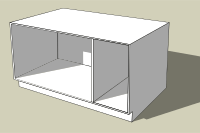Frameless construction
Frameless construction in cabinetmaking refers to the construction of cabinets using flat panels of engineered wood — usually particle board, plywood or medium-density fibreboard — rather than the traditional frame and panel construction.

A common construction method for frameless cabinets originated in Europe after World War II and is known as the 32-mm system or European system.[1] This nomenclature is derived from the 32-millimetre spacing between the system holes used for construction and installation of hardware typically used for doors, drawers and shelves. There are numerous 32mm based cabinet systems, one such system is Hettich's System 32. In North America it is also often referred to as "European Cabinetry" popular due to its simplicity of construction, clean lines and low cost.
With frameless (AKA full access) cabinets, thicker sides (boxes) keep the cabinet much more stable and avoids the use of a front frame, such as found in face-frame cabinets. Frameless cabinets are usually edgebanded to finish the front faces. By eliminating the front frame, you can have more room to get large objects inside with more usable space.[2]
See also
- Frame and panel
- Face frame
- RTA furniture
- Cabinet making
References
- Christ, Jim (1990). European Cabinetry: Design & Construction. New York: Sterling Publishing Co. Ltd. ISBN 0-8069-6958-X.
- "Framed vs. Frameless Cabinets". www.masterbrand.com. Retrieved 2018-04-28.